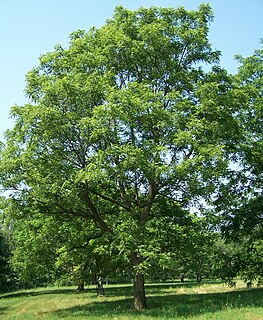
Walnut trees are any species of tree in the plant genus Juglans, the type genus of the family Juglandaceae, the seeds of which are referred to as walnuts. All species are deciduous trees, 10–40 metres (33–131 ft) tall, with pinnate leaves 200–900 millimetres (7.9–35.4 in), with 5–25 leaflets; the shoots have chambered pith, a character shared with the wingnuts (Pterocarya), but not the hickories (Carya) in the same family.
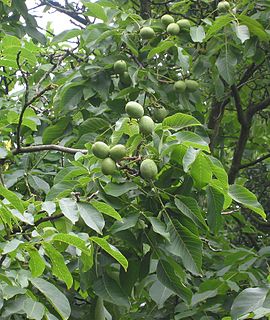
The Juglandaceae are a plant family known as the walnut family. They are trees, or sometimes shrubs, in the order Fagales. Members of this family are native to the Americas, Eurasia, and Southeast Asia.

Clogs are a type of footwear made in part or completely from wood. Clogs are used worldwide and although the form may vary by culture, within a culture the form often remained unchanged for centuries.

Hickory is a common name for trees comprising the genus Carya, which includes around 18 species. Five or six species are native to China, Indochina, and India (Assam), as many as twelve are native to the United States, four are found in Mexico, and two to four are from Canada. A number of hickory species are used for products like edible nuts or wood.

Cryptomeria is a monotypic genus of conifer in the cypress family Cupressaceae, formerly belonging to the family Taxodiaceae. It includes only one species, Cryptomeria japonica. It used to be considered by some to be endemic to Japan, where it is known as Sugi. The tree is called Japanese cedar or Japanese redwood in English. It has been extensively introduced and cultivated for wood production on the Azores.

A geta is a traditional Japanese footwear that resembles flip-flops. A kind of sandals, geta have a flat wooden base elevated with up to three "teeth", held on the foot with a fabric thong, which keeps the foot raised above the ground.
The Treaty of Peace and Friendship between Japan and the People's Republic of China is a peace treaty concluded between the People's Republic of China and Japan on August 12, 1978. The treaty was signed in Beijing by Huang Hua, Foreign Minister of the People's Republic of China, and Sunao Sonoda, Minister for Foreign Affairs of Japan. The treaty went into effect on October 23, 1978 with the state visit of Vice Premier of the PRC Deng Xiaoping to Japan. The treaty had its origin in the Joint Communiqué of the Government of Japan and the Government of the People's Republic of China of 1972. Negotiations on a formal peace treaty began in 1974, but were drawn out over various disputes until 1978. The treaty ultimately consisted of five articles, and was strongly opposed by the Soviet Union.

Pterocarya, often called wingnuts in English, are trees in the walnut family Juglandaceae. They are native to Asia. The botanic name is from Ancient Greek πτερον (pteron) "wing" + κάρυον (karyon) "nut".
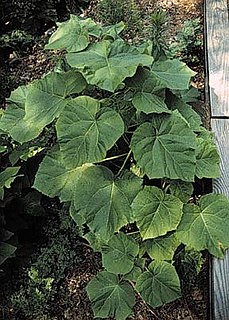
Paulownia is a genus of seven to 17 species of hardwood tree of C4 flowering plants in the family Paulowniaceae, in the order Lamiales. They are present in much of China, south to northern Laos and Vietnam and are long cultivated elsewhere in eastern Asia, notably in Japan and Korea where they are native.
The Wordtank series is a line of Japanese electronic dictionaries manufactured by Canon. Although officially only sold in Japan, several of the multi-language models are popular among students of the Japanese language around the world. The ability to change menu display options to English on many of the Wordtank models is cited as a reason for the relatively wide foreign adoption. The ability to highlight an entire Japanese word and display a hiragana rendering of it is unique to the Wordtank series and is an extremely popular function for advanced learners. This function applies to all Wordtank models. One of the latest Wordtank models, the G70, offers this function for over 400,000 words.
Annamocarya is a genus of flowering plants in the family Juglandaceae, containing only one species, Annamocarya sinensis, native to southwestern China and northern Vietnam. It is related to the hickories, and was formerly included in the same genus Carya, as Carya sinensis, but also shares a number of characteristics with the walnuts in the genus Juglans. It is grouped with Carya in the subtribe Caryinae. It is sometimes called Chinese hickory or beaked hickory.
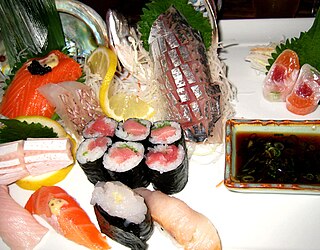
Omakase is a Japanese phrase, used when ordering food in restaurants, that means 'I'll leave it up to you'.
Japanese dictionaries have a history that began over 1300 years ago when Japanese Buddhist priests, who wanted to understand Chinese sutras, adapted Chinese character dictionaries. Present-day Japanese lexicographers are exploring computerized editing and electronic dictionaries. According to Nakao Keisuke (中尾啓介):
It has often been said that dictionary publishing in Japan is active and prosperous, that Japanese people are well provided for with reference tools, and that lexicography here, in practice as well as in research, has produced a number of valuable reference books together with voluminous academic studies. (1998:35)

Ulmus laciniata(Trautv.) Mayr, known variously as the Manchurian, cut-leaf, or lobed elm, is a deciduous tree native to the humid ravine forests of Japan, Korea, northern China, eastern Siberia and Sakhalin, growing alongside Cerciphyllum japonicum, Aesculus turbinata, and Pterocarya rhoifolia, at elevations of 700–2200 m, though sometimes lower in more northern latitudes, notably in Hokkaido.

Juglans californica, the California black walnut, also called the California walnut, or the Southern California black walnut, is a large shrub or small tree of the walnut family, Juglandaceae, endemic to California.
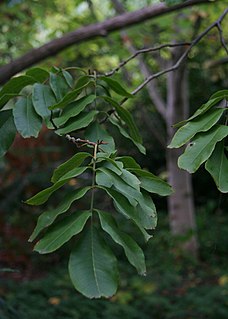
Cyclocarya is a genus of flowering plants in the family Juglandaceae, comprising a single species Cyclocarya paliurus, formerly treated in the genus Pterocarya as Pterocarya paliurus. It is native to eastern and central China.
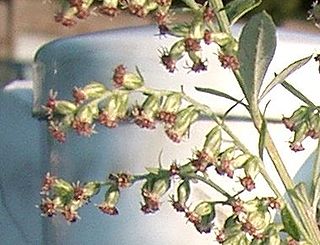
Artemisia princeps, also called Yomogi, Japanese mugwort, Korean wormwood, Korean mugwort or first wormwood in English, is an Asian plant species in the sunflower family, native to China, Japan and Korea. It is a perennial, very vigorous plant that grows to 1.2 meters. This species spreads rapidly by means of underground stolons and can become invasive. It bears small, buff-colored flowers from July to November which are hermaphroditic, and pollinated by wind. The leaves are feather shaped, scalloped and light green, with white dense fuzz on the underside.

Oratosquilla oratoria is a species of mantis shrimp found in the Western Pacific. It is widely harvested in Japan where it is known as shako and eaten as sushi. Like other members of its order it has a powerful spear, which it uses to hunt invertebrates and small fish. It grows to a length of 185 millimetres (7.3 in), and lives at depths of 10–100 metres (33–328 ft).

Pterocarya stenoptera is a small-winged wingnut tree of the Juglandaceae family. It is originally from Southeast China.
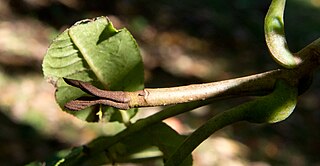
Pterocarya hupehensis is a tree in the Juglandaceae family native to China. It grows on moist streambanks at 700 to 2,000 m elevation—mostly in North Guizhou, West Hubei, South Shaanxi, West Sichuan.

















